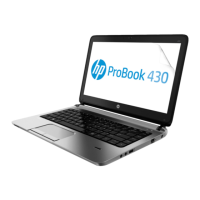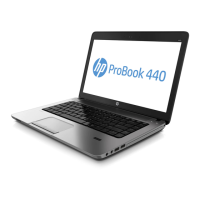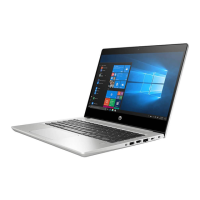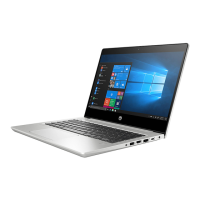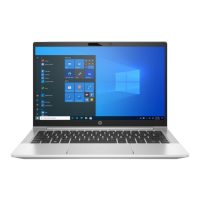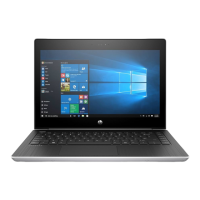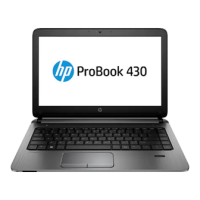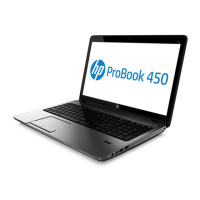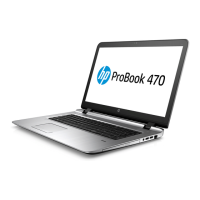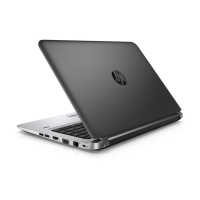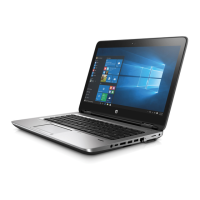Do you have a question about the HP ProBook 430 G3 and is the answer not in the manual?
Covers general product information, including processors, chipset, display, memory, storage, and ports.
Details wireless modules, Ethernet, and external media card options.
Describes keyboard, touchpad, power requirements, and security features.
Lists supported operating systems, including Windows versions and Ubuntu.
Identifies ports and slots on the right side.
Details components and indicators on the left side.
Lists parts within the display, like antennas, microphones, webcam.
Covers components on the top, including the touchpad.
Explains status lights for power, caps lock, wireless, etc.
Describes power button, speakers, volume mute, and fingerprint reader.
Details keyboard layout, function keys, and numeric keypad.
Identifies parts on the bottom, including battery latches and service doors.
Explains service, regulatory, and certification labels.
Step-by-step guide for SIM card insertion.
Lists and illustrates primary internal components with part numbers.
Details display assembly parts and cable kit contents.
Lists hard drives, SSDs, and plastics/misc. kits with part numbers.
Lists necessary tools for disassembly and reassembly.
Outlines guidelines for handling components, ESD, and drive safety.
Explains ESD principles and grounding procedures.
Introduces self-repair procedures and notes.
Step-by-step guide for replacing the battery.
Procedures for removing the service door and replacing the hard drive.
Guide for replacing or adding memory modules.
Steps for replacing WLAN/Bluetooth and WWAN modules.
Procedures for replacing M.2 SSD and the keyboard.
Introduces procedures for authorized service, noting potential warranty issues.
Steps for removing the top cover and fingerprint reader assembly.
Procedures for replacing the power button and function boards.
Steps for replacing the USB/audio/card reader board and the system fan.
Detailed procedures for replacing the system board and RTC battery.
Guides for replacing speakers, heat sink, and the display assembly.
Instructions for replacing the power connector and cable.
Accessing and navigating BIOS for system configuration.
Determining BIOS version and downloading updates.
Managing boot order, preferences, and express boot options.
Accessing and navigating BIOS for system configuration.
Determining BIOS version and downloading updates.
Managing boot order, preferences, and express boot options.
Accessing and navigating BIOS for system configuration.
Determining BIOS version and downloading updates.
Configuring Trusted Platform Module (TPM) for enhanced security.
Explains HP Sure Start for BIOS protection and recovery.
Accessing and navigating BIOS for system configuration.
Determining BIOS version and downloading updates.
Guide on using the UEFI tool to diagnose hardware issues.
Steps to create a bootable USB drive with the diagnostics tool.
Guidance on creating repair media and performing data backups.
Methods for recovering the system using built-in tools or media.
Using Windows Backup/Restore or Automatic Repair for system recovery.
Instructions for using f11 to restore the original hard drive image.
Steps for clean OS installation using purchased media.
Guidance on creating recovery DVDs and performing backups.
Best practices for backing up files and system settings.
Methods for system recovery using Windows tools or f11.
Instructions for using f11 to restore the original hard drive image.
Steps for clean OS installation using Windows 7 media.
Steps for creating HP Recovery media and Windows backups.
Options for system recovery using HP Recovery Manager or Windows tools.
Detailed guidance on using HP Recovery Manager for system restoration.
How to modify the boot sequence for recovery media.
Steps for creating restore media and routine system backups.
Best practices for backing up files to external drives or discs.
Methods for recovering the system to its original factory state.
Instructions for creating and using a USB recovery disk for Ubuntu.
Procedure for wiping the system and reinstalling the Ubuntu OS.
Comprehensive technical details of the computer's hardware.
Details on display size, resolution, and specifications for HDDs and SSDs.
Explains types, purpose, and usage of nonvolatile memory.
Procedures to restore BIOS settings and clear sensitive data using current and legacy BIOS.
How to reset BIOS security settings and securely erase drive data.
General specifications for power cords applicable worldwide.
Country-specific regulations and certifications for power cord sets.
Covers general product information, including processors, chipset, display, memory, storage, and ports.
Details wireless modules, Ethernet, and external media card options.
Describes keyboard, touchpad, power requirements, and security features.
Lists supported operating systems, including Windows versions and Ubuntu.
Identifies ports and slots on the right side.
Details components and indicators on the left side.
Lists parts within the display, like antennas, microphones, webcam.
Covers components on the top, including the touchpad.
Explains status lights for power, caps lock, wireless, etc.
Describes power button, speakers, volume mute, and fingerprint reader.
Details keyboard layout, function keys, and numeric keypad.
Identifies parts on the bottom, including battery latches and service doors.
Explains service, regulatory, and certification labels.
Step-by-step guide for SIM card insertion.
Lists and illustrates primary internal components with part numbers.
Details display assembly parts and cable kit contents.
Lists hard drives, SSDs, and plastics/misc. kits with part numbers.
Lists necessary tools for disassembly and reassembly.
Outlines guidelines for handling components, ESD, and drive safety.
Explains ESD principles and grounding procedures.
Introduces self-repair procedures and notes.
Step-by-step guide for replacing the battery.
Procedures for removing the service door and replacing the hard drive.
Guide for replacing or adding memory modules.
Steps for replacing WLAN/Bluetooth and WWAN modules.
Procedures for replacing M.2 SSD and the keyboard.
Introduces procedures for authorized service, noting potential warranty issues.
Steps for removing the top cover and fingerprint reader assembly.
Procedures for replacing the power button and function boards.
Steps for replacing the USB/audio/card reader board and the system fan.
Detailed procedures for replacing the system board and RTC battery.
Guides for replacing speakers, heat sink, and the display assembly.
Instructions for replacing the power connector and cable.
Accessing and navigating BIOS for system configuration.
Determining BIOS version and downloading updates.
Managing boot order, preferences, and express boot options.
Accessing and navigating BIOS for system configuration.
Determining BIOS version and downloading updates.
Managing boot order, preferences, and express boot options.
Accessing and navigating BIOS for system configuration.
Determining BIOS version and downloading updates.
Configuring Trusted Platform Module (TPM) for enhanced security.
Explains HP Sure Start for BIOS protection and recovery.
Accessing and navigating BIOS for system configuration.
Determining BIOS version and downloading updates.
Guide on using the UEFI tool to diagnose hardware issues.
Steps to create a bootable USB drive with the diagnostics tool.
Guidance on creating repair media and performing data backups.
Methods for recovering the system using built-in tools or media.
Using Windows Backup/Restore or Automatic Repair for system recovery.
Instructions for using f11 to restore the original hard drive image.
Steps for clean OS installation using purchased media.
Guidance on creating recovery DVDs and performing backups.
Best practices for backing up files and system settings.
Methods for system recovery using Windows tools or f11.
Instructions for using f11 to restore the original hard drive image.
Steps for clean OS installation using Windows 7 media.
Steps for creating HP Recovery media and Windows backups.
Options for system recovery using HP Recovery Manager or Windows tools.
Detailed guidance on using HP Recovery Manager for system restoration.
How to modify the boot sequence for recovery media.
Steps for creating restore media and routine system backups.
Best practices for backing up files to external drives or discs.
Methods for recovering the system to its original factory state.
Instructions for creating and using a USB recovery disk for Ubuntu.
Procedure for wiping the system and reinstalling the Ubuntu OS.
Comprehensive technical details of the computer's hardware.
Details on display size, resolution, and specifications for HDDs and SSDs.
Explains types, purpose, and usage of nonvolatile memory.
Procedures to restore BIOS settings and clear sensitive data using current and legacy BIOS.
How to reset BIOS security settings and securely erase drive data.
General specifications for power cords applicable worldwide.
Country-specific regulations and certifications for power cord sets.
| Power cord included | Yes |
|---|---|
| Intel segment tagging | Enterprise, Professional |
| AC adapter power | 45 W |
| Battery capacity | 44 Wh |
| Number of battery cells | 4 |
| Operating system architecture | 64-bit |
| Numeric keypad | No |
| Pointing device | Touchpad |
| Charging port type | DC-in jack |
| USB 2.0 ports quantity | USB 2.0 ports have a data transmission speed of 480 Mbps, and are backwards compatible with USB 1.1 ports. You can connect all kinds of peripheral devices to them. |
| Ethernet LAN (RJ-45) ports | 1 |
| Thunderbolt ports quantity | 0 |
| USB 3.2 Gen 1 (3.1 Gen 1) Type-A ports quantity | 2 |
| Wi-Fi standards | 802.11a, Wi-Fi 5 (802.11ac), 802.11b, 802.11g, Wi-Fi 4 (802.11n) |
| Bluetooth version | 4.2 |
| Ethernet LAN data rates | 10, 100, 1000 Mbit/s |
| SSD capacity | The Solid State Drive's storage capacity in Gigabytes. |
| SSD interface | SATA |
| Storage media | SSD |
| SSD form factor | M.2 |
| Total storage capacity | 128 GB |
| Compatible memory cards | SD, SDHC, SDXC |
| On-board graphics card ID | 1916 |
| Discrete graphics card model | Not available |
| On-board graphics card model | Intel® HD Graphics 520 |
| On-board graphics card family | Intel® HD Graphics |
| Maximum on-board graphics card memory | 1.74 GB |
| On-board graphics card OpenGL version | 4.4 |
| On-board graphics card base frequency | 300 MHz |
| On-board graphics card DirectX version | 12.0 |
| On-board graphics card dynamic frequency (max) | 1000 MHz |
| Display diagonal | 13.3 \ |
| Display resolution | 1366 x 768 pixels |
| Native aspect ratio | 16:9 |
| Memory slots | 2x SO-DIMM |
| Internal memory | 4 GB |
| Memory clock speed | 1600 MHz |
| Internal memory type | DDR3L-SDRAM |
| Maximum internal memory | 16 GB |
| Memory layout (slots x size) | 1 x 4 GB |
| Form factor | Clamshell |
| Product type | Laptop |
| Product color | Silver |
| Country of origin | China |
| Tcase | - °C |
| Bus type | QPI |
| Stepping | D1 |
| Tjunction | 100 °C |
| Processor cache | 3 MB |
| Processor model | i5-6200U |
| System bus rate | 4 GT/s |
| Processor family | Intel® Core™ i5 |
| Processor series | Intel Core i5-6200 series |
| Processor socket | LGA 1356 (Socket B2) |
| Processor codename | Skylake |
| Configurable TDP-up | 25 W |
| Number of QPI links | - |
| Processor frequency | 2.3 GHz |
| Processor cache type | Smart Cache |
| Configurable TDP-down | 7.5 W |
| Processor lithography | 14 nm |
| Processor manufacturer | Intel |
| Processor front side bus | - MHz |
| PCI Express slots version | 3.0 |
| Processor boost frequency | 2.8 GHz |
| PCI Express configurations | 1x4, 4x1 |
| Thermal Design Power (TDP) | 15 W |
| Configurable TDP-up frequency | 2.4 GHz |
| Configurable TDP-down frequency | 0.8 GHz |
| Maximum number of PCI Express lanes | 12 |
| Processor code | SR2EY |
| Processor ARK ID | 88193 |
| Processor package size | 42 X 24 mm |
| Supported instruction sets | SSE4.1, SSE4.2, AVX 2.0 |
| Intel Smart Response Technology version | 1.00 |
| Intel Stable Image Platform Program (SIPP) version | 0.00 |
| Depth | 233.7 mm |
|---|---|
| Width | 326 mm |
| Weight | 1500 g |
| Height (rear) | 22.4 mm |
| Height (front) | 21.4 mm |
